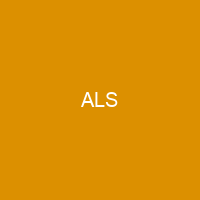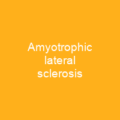ALS

ALS is the most common type of motor neuron disease. Early symptoms include stiff muscles, muscle twitches, and muscle wasting. ALS eventually causes paralysis and early death, usually from respiratory failure. There is no cure for ALS, and treatment is targeted at improving the symptoms.
About ALS in brief
 ALS is the most common type of motor neuron disease. Early symptoms of ALS include stiff muscles, muscle twitches, and muscle wasting. ALS eventually causes paralysis and early death, usually from respiratory failure. There is no cure for ALS, and treatment is targeted at improving the symptoms. A medication called riluzole may extend life by about two to three months. Non-invasive ventilation may result in both improved quality and length of life. Mechanical ventilation can prolong survival but does not stop disease progression. In about 25% of cases, muscles in the face, mouth, and throat are affected first because motor neurons in the part of the brainstem called the medulla oblongata start to die first along with lower motor neurons. The disease can affect people of any age, but usually starts around the age of 60. In the United States, it is more common in white people than black people. The first ALS gene was discovered in 1993 while the first animal model was developed in 1994. In 2014, videos of the Ice Bucket Challenge went viral on the Internet and increased public awareness of the condition. In 1869, the connection between the symptoms and the underlying neurological problems was first described by Jean-Martin Charcot, who in 1874 began using the term amyotrophic lateral sclerosis. It became well known in the U.S. in the 20th century when in 1939 it affected baseball player Lou Gehrig and later worldwide following the 1963 diagnosis of cosmologist Stephen Hawking.
ALS is the most common type of motor neuron disease. Early symptoms of ALS include stiff muscles, muscle twitches, and muscle wasting. ALS eventually causes paralysis and early death, usually from respiratory failure. There is no cure for ALS, and treatment is targeted at improving the symptoms. A medication called riluzole may extend life by about two to three months. Non-invasive ventilation may result in both improved quality and length of life. Mechanical ventilation can prolong survival but does not stop disease progression. In about 25% of cases, muscles in the face, mouth, and throat are affected first because motor neurons in the part of the brainstem called the medulla oblongata start to die first along with lower motor neurons. The disease can affect people of any age, but usually starts around the age of 60. In the United States, it is more common in white people than black people. The first ALS gene was discovered in 1993 while the first animal model was developed in 1994. In 2014, videos of the Ice Bucket Challenge went viral on the Internet and increased public awareness of the condition. In 1869, the connection between the symptoms and the underlying neurological problems was first described by Jean-Martin Charcot, who in 1874 began using the term amyotrophic lateral sclerosis. It became well known in the U.S. in the 20th century when in 1939 it affected baseball player Lou Gehrig and later worldwide following the 1963 diagnosis of cosmologist Stephen Hawking.
The average survival from onset to death is two to four years, though this can vary, and about 10% survive longer than 10 years. About half of these genetic cases are due to one of two specific genes. Other motor neuron diseases include primary lateral sclerosis, progressive muscular atrophy, progressive bulbar palsy, pseudobulbar palsY, and monomelic amyotrophy. ALS itself can be classified in a few different ways: by how fast the disease progresses, by whether it is familial or sporadic, and by the region first affected. In most cases, people with ALS have symptoms that are limited to one spinal cord region for at least 12 to 24 months before spreading to a second region. About 70% of all cases of ALS can be subdivided into limb-onset and bulbar-onet cases. About 5% of people affected develop at least mild difficulties with thinking and behavior and most people experience pain. The diagnosis is based on a person’s signs and symptoms, with testing done to rule out other potential causes. The underlying mechanism involves damage to both upper and lower motor neuron cells. In some cases, the disease affects only upper motor neurons, and not lower motor neuronal cells. About 10% of ALS cases are associated with a genetic cause linked to a history of the disease in the family, and these are known as familial ALS. It is unclear whether PLS and PMA are separate diseases or simply variants of ALS. The cause of ALS is unknown.
You want to know more about ALS?
This page is based on the article ALS published in Wikipedia (as of Dec. 10, 2020) and was automatically summarized using artificial intelligence.












